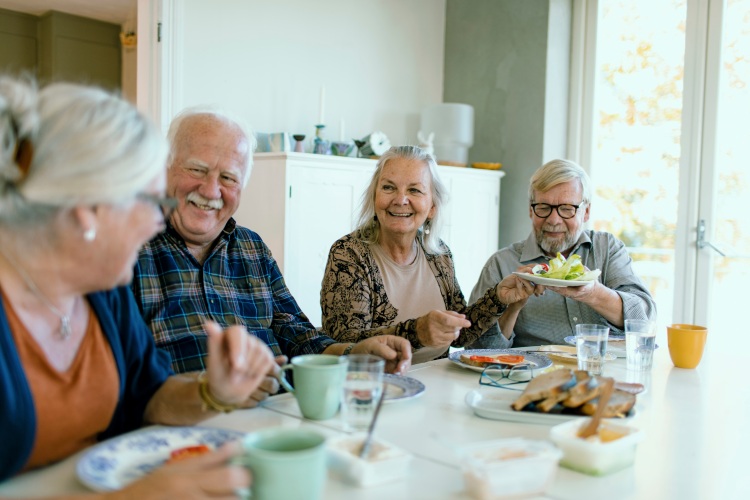At a Glance:
Nutrition: Dietitian-approved meals provide key nutrients for strength and brain health.
Fitness: Exercise programs and amenities promote mobility, balance, and independence.
Wellness: Activities support mental, emotional, and social well-being.
Care: Coordinated teams personalize support to help residents thrive.
As we age, the choices we make around nutrition and physical activity play a major role in how well we feel, move, and engage with life. A healthy lifestyle can boost energy, preserve independence, prevent chronic illness, and enhance overall quality of life.
Senior living communities such as independent and assisted living are uniquely positioned to help older adults stay well. Through professionally planned meals, diverse fitness opportunities, and environments designed to encourage social connection, these communities make healthy aging a daily reality.
In this article, we’ll explore the benefits of senior living in promoting aging wellness with a closer look at nutrition programs, fitness activities, and holistic approaches that keep residents thriving physically, mentally, and socially. 1
Why Nutrition & Fitness Matter as We Age
As we grow older, our bodies experience natural changes in metabolism, muscle mass, bone density, and even how we process and absorb nutrients. Appetite, sense of thirst, and physical stamina can shift, making it more important than ever to make mindful choices about diet and fitness.
Nutrition benefits: A balanced diet rich in lean protein, fruits, vegetables, whole grains, and low-fat dairy—or fortified alternatives—helps maintain muscle strength, bone health, immune function, and cognitive performance. Adequate intake of key nutrients like calcium, vitamin D, potassium, fiber, and vitamin B12 supports energy, protects against chronic diseases such as heart disease and diabetes, and helps manage weight.
According to a 2022 study in PLOS Medicine, switching to a healthier diet after age 60 can increase life expectancy by up to 8 years.
Fitness benefits: Regular movement improves mobility, balance, and flexibility, reducing the risk of falls and injury. It also supports bone strength, cardiovascular health, and mental well-being, while fostering independence.
For older adults, the CDC recommends at least 150 minutes of moderate activity each week, along with muscle-strengthening exercises twice weekly, is recommended to maintain function and vitality. A study from Johns Hopkins Bloomberg School of Public Health found that just 35 minutes of moderate-to-vigorous physical activity per week was associated with a 41% lower risk of developing dementia over about four years.
Maintaining healthy habits in both nutrition and fitness can help prevent or better manage chronic conditions like arthritis, hypertension, and type 2 diabetes. This allows older adults to not just live longer, but live better. 2,3
Nutrition Support in Senior Living
A. Thoughtfully Designed Menus
Dietitian-approved menus provide flavorful, nutrient-rich meals tailored for seniors, including low-sodium, diabetic-friendly, and heart-healthy options. Fresh fruits, vegetables, lean proteins, and whole grains are staples, with multiple dining venues offering variety and choice.
B. Personalized Nutrition Plans
Dietary teams collaborate with nursing staff to meet individual needs—addressing allergies, religious preferences, texture modifications, and therapeutic diets while supporting medical conditions and personal tastes.
C. Dining as a Social Experience
Meals double as opportunities for connection, with family-style seating, themed dinners, and special events fostering community, reducing isolation, and making healthy eating for seniors enjoyable.1
Fitness & Physical Wellness Opportunities
A. Range of Exercise Programs for Older Adults
Many senior living communities offer group activities—such as chair yoga, tai chi, resistance band workouts, or walking clubs—often tailored to different mobility levels and fitness goals.
B. On-Site Amenities & Resources
Amenities may include fitness centers with senior-friendly equipment, outdoor walking paths, and dedicated balance or therapy rooms. Some also provide access to personal trainers, rehab therapists, or wellness coaches.
C. Encouraging Consistency & Fun
Scheduled programs promote an enjoyable, active lifestyle. Exercising alongside peers adds social connection, motivation, and a sense of accountability. 1, 3
A Holistic Approach to Wellness in Senior Living
Many senior living communities now take a wellness-first approach, integrating nutrition and fitness into a broader lifestyle model that supports body, mind, and spirit. Alongside healthy dining and exercise programs, residents often have access to activities such as mindfulness workshops, gardening, creative arts, and educational seminars that nurture emotional and mental well-being.
Coordinated care teams that include dining services, fitness staff, healthcare providers, and activity directors work together to create personalized, engaging experiences that keep residents thriving. This proactive model empowers older adults to remain active participants in their own health and happiness while fostering a community culture centered on connection, purpose, and vitality. 4

Take the Next Step Toward Vibrant Aging
Good nutrition and regular physical activity are essential to healthy aging, supporting strength, independence, and overall quality of life. Senior living communities make it easier to maintain these habits through balanced meals, engaging fitness opportunities, and a holistic approach to health and wellness, nurturing the whole person.
To experience how a community can help you or a loved one thrive, schedule a tour to see wellness in action or contact us to learn more about our lifestyle programs.
References
[1] “Nutrition and Wellness in Senior Living: Ensuring a Healthy Lifestyle.” Senior Living Community, 14 July 2025, bonaventuresenior.com/nutrition-and-wellness-in-senior-living-ensuring-a-healthy-lifestyle/.
[2] “Older Adults.” MyPlate U.S. Department of Agriculture, www.myplate.gov/life-stages/older-adults. Accessed 8 Aug. 2025.
[3] “Older Adults: Adding Activity Recommendations.” Centers for Disease Control and Prevention, Centers for Disease Control and Prevention, www.cdc.gov/physical-activity-basics/adding-older-adults/index.html. Accessed 8 Aug. 2025.
[4] Audette-Bourdeau, Elizabeth. “The Future of Senior Living: Embracing Wellness for a Thriving Community.” McKnight’s Senior Living, 26 Sept. 2024, www.mcknightsseniorliving.com/home/columns/marketplace-columns/the-future-of-senior-living-embracing-wellness-for-a-thriving-community/.
The information provided in the article is for general informational purposes only. This information is not a substitute for medical advice. Accordingly, before taking any actions based upon such information, you are encouraged to consult with the appropriate professionals.



